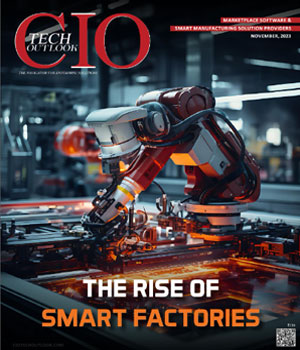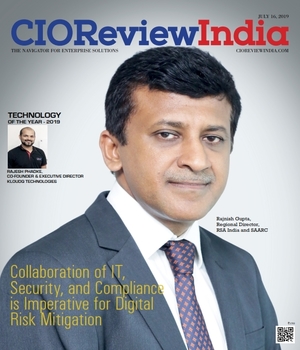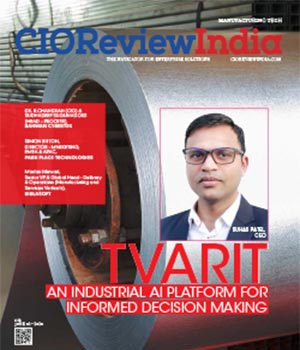
AIML: Enhancing the Efficiency of Predictive Maintenance in Manufacturing
Govind Singh, Group CIO, Dalmia Bharat | Friday, 08 December 2023, 13:28 IST
 Holding an MBA in Information Management from University of Wales, Govind is a seasoned industry professional with over three decades of experience across diverse IT functions. He came on board Dalmia Bharat in 2019, prior to which he has successfully handled key managerial positions across companies such as Levi Strauss & Co., Metro Cash & Carry India, Gillette India and Eicher Tractors.
Holding an MBA in Information Management from University of Wales, Govind is a seasoned industry professional with over three decades of experience across diverse IT functions. He came on board Dalmia Bharat in 2019, prior to which he has successfully handled key managerial positions across companies such as Levi Strauss & Co., Metro Cash & Carry India, Gillette India and Eicher Tractors.
In a recent conversation with CIOTech Outlook, Govind shared his views on predictive analytics in a manufacturing setup, recent tech advancements and many other related aspects.
How is AI/ML revolutionizing predictive maintenance in a manufacturing setup?
Predictive maintenance using AI/ML is one of the most important factors that contribute towards the profitability of the organization by cutting-down maintenance and stock-keeping costs. For instance, the ball bearings used in our industry are very sophisticated and expensive. If the ball bearing of large machinery is broken, it needs to be replaced immediately without which the entire plant will have to be shutdown. Thus, it is very important to ensure that such spare parts are kept handy in all plants, despite the spares being used only in one or two plants. In such a scenario, having a predictive maintenance algorithm helps us to know before-hand which particular part in which machinery is likely to fail in the next 6-12 months. This way, we can keep the necessary spare parts only in those plants where there is risk of machinery failure is high instead of stocking the up across all plants. Additionally, predictive maintenance also enables companies to significantly reduce the downtime of their plants.
Briefly explain how IoT sensors are enabling hassle-free interface among various systems for efficient predictive maintenance.
Today, IoT sensors have become more accurate and resilient than ever before. There are a large variety of sensors being used in every manufacturing setup to gather data about various systems, applications and machinery. As a result, IoT sensors are now able to have a direct interface with all other technologies that are being used by the organization for various functions. With the recent advancements in data analytics and sensor technologies, companies are now able to capture all the data into an ERP solution, build logic there, and acquire efficient predictive maintenance capabilities through the S/4HANA. Thus, IoT sensors no doubt serve as the lifeline for the organization in its endeavor to build an efficient predictive maintenance algorithm that can help them optimize their end-to-end operations cycle.
Throw some light on the common challenges manufacturers face when integrating AI/ML based predictive maintenance into their existing infrastructure.
While most of the vendors and manufacturers in the manufacturing industry say that they use AI/ML, they lack a proper understanding about the difference between normal analytics and AI/ML. If an organization is actually using AI/ML, there are a vast number of mechanisms (a few that are readily available, and a few that are built) involved in the process. For instance, organizations use a variety of tools for their supply chain optimization. Since these tools are always learning from past data, the training dataset that being fed into those tools in the backend plays a critical role in determining how refined your solution is, which in turn decides the accuracy of the output. These are some of the most common challenges, which if not handled in a timely and effective manner, might cause a major setback while integrating AI/ML backed predictive maintenance into their operations.
How do you expect the AI/ML driven predictive maintenance to evolve in the near future for the manufacturing sector?
Going forward, the biggest challenge for manufacturers will be in terms of OT security. This is because although companies have spent a lot of capital on IT security, only a handful of them have been investing on their OT security. Since your devices are connected to your backend systems, the risk of those devices being victim to cyber-attacks is very high. Given that almost all systems and applications are interconnected in today’s digital business landscape, if a perpetrator gains access into the system from any device, he will have access to all the functions and can create havoc in ways unimaginable.
CIO Viewpoint
Novel Manufacturing Technologies to Accelerate...
By Abhrasnata Das
Manufacturing IT: A Journey Towards Robust Future
By Manish Chandegara, CIO, Cera Group
Revolutionizing the Electrical Equipment...
By Janifha Evangeline
CXO Insights
AI/ML: Enhancing the Efficiency of Predictive...
By Govind Singh, Group CIO, Dalmia Bharat
Prime Aspects Successful Business Leaders...
By - Santosh Rai, Chief Information Officer, Asahi India Glass
How Industry 4.0 is Transforming the...









